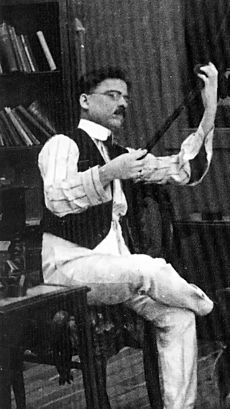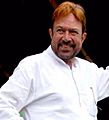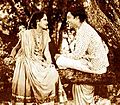Bollywood facts for kids
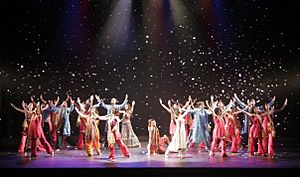
Bollywood is a word given to the film industry in Mumbai, engaged in production of movies in Hindi language. The popular term Bollywood, is a portmanteau of "Bombay" (former name of Mumbai) and "Hollywood". The industry is a part of the larger Indian cinema, which also includes South Indian cinema and other smaller film industries.
In 2017, Indian cinema produced 1,986 feature films, with 364 films in Hindi. Bollywood is one of the largest centres for film production in the world.
Contents
The term Bollywood
"Bollywood" is a portmanteau derived from Bombay (the former name of Mumbai) and "Hollywood", a shorthand reference for the American film industry which is based in Hollywood, California.
The term "Tollywood", for the Tollygunge-based cinema of West Bengal, was used in a 1932 American Cinematographer article by Wilford E. Deming, an American engineer who helped produce the first Indian sound picture.
"Bollywood" was probably invented in Bombay-based film trade journals in the 1960s or 1970s. It's unknown if it was derived from "Hollywood" through "Tollywood", or was inspired directly by "Hollywood".
The term has been criticised by some film journalists and critics, who believe it implies that the industry is a poor cousin of Hollywood.
"Bollywood" has since inspired a long list of Hollywood-inspired nicknames.
History
Early history (1890s–1930s)
In 1897, a film presentation by Professor Stevenson featured a stage show at Calcutta's Star Theatre. With Stevenson's encouragement and camera, Hiralal Sen, an Indian photographer, made a film of scenes from that show, The Flower of Persia (1898). The Wrestlers (1899) by H. S. Bhatavdekar showed a wrestling match at the Hanging Gardens in Bombay.
Dadasaheb Phalke's silent Raja Harishchandra (1913) is the first feature film made in India. By the 1930s, the industry was producing over 200 films per year. The first Indian sound film, Ardeshir Irani's Alam Ara (1931), was commercially successful. With a great demand for talkies and musicals, Hindustani cinema (as Hindi cinema was then known as) and the other regional film industries quickly switched to sound films.
Challenges and market expansion (1930s–1940s)
The 1930s and 1940s were tumultuous times; India was buffeted by the Great Depression, World War II, the Indian independence movement, and the violence of the Partition. Although most early Bombay films were unabashedly escapist, a number of filmmakers tackled tough social issues or used the struggle for Indian independence as a backdrop for their films. Irani made the first Hindi colour film, Kisan Kanya, in 1937. The following year, he made a colour version of Mother India. However, colour did not become a popular feature until the late 1950s. At this time, lavish romantic musicals and melodramas were cinematic staples.
The decade of the 1940s saw an expansion of Bombay cinema's commercial market and its presence in the national consciousness. The year 1943 saw the arrival of Indian cinema's first 'blockbuster' offering, the movie Kismet, which grossed in excess of the important barrier of one crore (10 million) rupees, made on a budget of only two lakh (200,000) rupees. The film tackled contemporary issues, especially those arising from the Indian Independence movement, and went on to become "the longest running hit of Indian cinema", a title it held till the 1970s. Film personalities like Bimal Roy, Sahir Ludhianvi and Prithviraj Kapoor participated in the creation of a national movement against colonial rule in India, while simultaneously leveraging the popular political movement to increase their own visibility and popularity. Themes from the Independence Movement deeply influenced Bombay film directors, screen-play writers, and lyricists, who saw their films in the context of social reform and the problems of the common people.
Before the Partition, the Bombay film industry was closely linked to the Lahore film industry (now the Pakistani film industry also known as "Lollywood"); both produced films in Hindustani (also known as Hindi-Urdu), the lingua franca of northern and central India. Another centre of Hindustani-language film production was the Bengal film industry in Calcutta, Bengal Presidency (now Kolkata, West Bengal), which produced Hindustani-language films and local Bengali language films. Many actors, filmmakers and musicians from the Lahore industry migrated to the Bombay industry during the 1940s, including actors K. L. Saigal, Prithviraj Kapoor, Dilip Kumar and Dev Anand as well as playback singers Mohammed Rafi, Noorjahan and Shamshad Begum. Around the same time, filmmakers and actors from the Calcutta film industry began migrating to Bombay; as a result, Bombay became the center of Hindustani-language film production.
The 1947 partition of India divided the country into the Republic of India and Pakistan, which precipitated the migration of filmmaking talent from film production centres like Lahore and Calcutta, which bore the brunt of the partition violence. This included actors, filmmakers and musicians from Bengal, Punjab (particularly the present-day Pakistani Punjab), and the North-West Frontier Province (present-day Khyber Pakhtunkhwa). These events further consolidated the Bombay film industry's position as the preeminent center for film production in India.
Golden age (late 1940s–1960s)
The period from the late 1940s to the early 1960s, after India's independence, is regarded by film historians as the Golden Age of Hindi cinema. Some of the most critically acclaimed Hindi films of all time were produced during this time. Examples include Pyaasa (1957) and Kaagaz Ke Phool (1959), directed by Guru Dutt and written by Abrar Alvi; Awaara (1951) and Shree 420 (1955), directed by Raj Kapoor and written by Khwaja Ahmad Abbas, and Aan (1952), directed by Mehboob Khan and starring Dilip Kumar. The films explored social themes, primarily dealing with working-class life in India (particularly urban life) in the first two examples. Awaara presented the city as both nightmare and dream, and Pyaasa critiqued the unreality of urban life.
Mehboob Khan's Mother India (1957), a remake of his earlier Aurat (1940), was the first Indian film nominated for the Academy Award for Best Foreign Language Film; it lost by a single vote. Mother India defined conventional Hindi cinema for decades. It spawned a genre of dacoit films, in turn defined by Gunga Jumna (1961). Some of the best-known epic films of Hindi cinema were also produced at this time, such as K. Asif's Mughal-e-Azam (1960). Other acclaimed mainstream Hindi filmmakers during this period included Kamal Amrohi and Vijay Bhatt.
The three most popular male Indian actors of the 1950s and 1960s were Dilip Kumar, Raj Kapoor, and Dev Anand, each with a unique acting style. Kapoor adopted Charlie Chaplin's tramp persona; Anand modeled himself on suave Hollywood stars like Gregory Peck and Cary Grant, and Kumar pioneered a form of method acting which predated Hollywood method actors such as Marlon Brando. Kumar, who was described as "the ultimate method actor" by Satyajit Ray, inspired future generations of Indian actors. Much like Brando's influence on Robert De Niro and Al Pacino, Kumar had a similar influence on Amitabh Bachchan, Naseeruddin Shah, Shah Rukh Khan and Nawazuddin Siddiqui. Veteran actresses such as Suraiya, Nargis, Sumitra Devi, Madhubala, Meena Kumari, Waheeda Rehman, Nutan, Sadhana, Mala Sinha and Vyjayanthimala have had their share of influence on Hindi cinema.
While commercial Hindi cinema was thriving, the 1950s also saw the emergence of a parallel cinema movement. Although the movement (emphasising social realism) was led by Bengali cinema, it also began gaining prominence in Hindi cinema. Early examples of parallel cinema include Dharti Ke Lal (1946), directed by Khwaja Ahmad Abbas and based on the Bengal famine of 1943,; Neecha Nagar (1946) directed by Chetan Anand and written by Khwaja Ahmad Abbas, and Bimal Roy's Do Bigha Zamin (1953). Their critical acclaim and the latter's commercial success paved the way for Indian neorealism and the Indian New Wave (synonymous with parallel cinema). Internationally acclaimed Hindi filmmakers involved in the movement included Mani Kaul, Kumar Shahani, Ketan Mehta, Govind Nihalani, Shyam Benegal, and Vijaya Mehta.
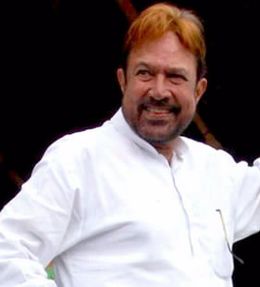
After the social-realist film Neecha Nagar received the Palme d'Or at the inaugural 1946 Cannes Film Festival, Hindi films were frequently in competition for Cannes' top prize during the 1950s and early 1960s and some won major prizes at the festival. Guru Dutt, overlooked during his lifetime, received belated international recognition during the 1980s. Film critics polled by the British magazine Sight & Sound included several of Dutt's films in a 2002 list of greatest films, and Time's All-Time 100 Movies lists Pyaasa as one of the greatest films of all time.
During the late 1960s and early 1970s, the industry was dominated by musical romance films with romantic-hero leads.
Classic Hindi cinema (1970s–1980s)
By 1970, Hindi cinema was thematically stagnant and dominated by musical romance films. The arrival of screenwriting duo Salim–Javed (Salim Khan and Javed Akhtar) was a paradigm shift, revitalising the industry. They began the genre of gritty, violent, Bombay underworld crime films early in the decade with films such as Zanjeer (1973) and Deewaar (1975). Salim-Javed reinterpreted the rural themes of Mehboob Khan's Mother India (1957) and Dilip Kumar's Gunga Jumna (1961) in a contemporary urban context, reflecting the socio-economic and socio-political climate of 1970s India and channeling mass discontent, disillusionment and the unprecedented growth of slums with anti-establishment themes and those involving urban poverty, corruption and crime. Their "angry young man", personified by Amitabh Bachchan, reinterpreted Dilip Kumar's performance in Gunga Jumna in a contemporary urban context and anguished urban poor.
By the mid-1970s, romantic confections had given way to crime films and action films about gangsters (the Bombay underworld) and bandits (dacoits). Salim-Javed's writing and Amitabh Bachchan's acting popularised the trend with films such as Zanjeer and (particularly) Deewaar.
The name "Bollywood" was coined during the 1970s, when the conventions of commercial Hindi films were defined. Key to this was the masala film, which combines a number of genres (action, comedy, romance, drama, melodrama, and musical). The masala film was pioneered early in the decade by filmmaker Nasir Hussain, and the Salim-Javed screenwriting duo, pioneering the Bollywood-blockbuster format. Yaadon Ki Baarat (1973), directed by Hussain and written by Salim-Javed, has been identified as the first masala film and the first quintessentially "Bollywood" film. Salim-Javed wrote more successful masala films during the 1970s and 1980s. Masala films made Amitabh Bachchan the biggest star of the period. A landmark of the genre was Amar Akbar Anthony (1977), directed by Manmohan Desai and written by Kader Khan, and Desai continued successfully exploiting the genre.
Some Hindi filmmakers, such as Shyam Benegal, Mani Kaul, Kumar Shahani, Ketan Mehta, Govind Nihalani and Vijaya Mehta, continued to produce realistic parallel cinema throughout the 1970s. Although the art film bent of the Film Finance Corporation was criticised during a 1976 Committee on Public Undertakings investigation which accused the corporation of not doing enough to encourage commercial cinema, the decade saw the rise of commercial cinema with films such as Sholay (1975) which consolidated Amitabh Bachchan's position as a star. The devotional classic Jai Santoshi Ma was also released that year.
By 1983, the Bombay film industry was generating an estimated annual revenue of ₹700 crore (₹ 7 billion, $693.14 million), equivalent to $2.04 billion (₹12,667 crore, ₹ 111.33 billion) when adjusted for inflation. By 1986, India's annual film output had increased from 741 films produced annually to 833 films annually, making India the world's largest film producer. The most internationally acclaimed Hindi film of the 1980s was Mira Nair's Salaam Bombay! (1988), which won the Camera d'Or at the 1988 Cannes Film Festival and was nominated for the Academy Award for Best Foreign Language Film.
New Hindi cinema (1990s–2000s)
Hindi cinema experienced another period of box-office decline during the late 1980s with due to concerns by audiences over increasing violence and a decline in musical quality, and a rise in video piracy. One of the turning points came with such films as Qayamat Se Qayamat Tak (1988), presenting a blend of youthfulness, family entertainment, emotional intelligence and strong melodies, all of which lured audiences back to the big screen. It brought back the template for Bollywood musical romance films which went on to define 1990s Hindi cinema.
Known since the 1990s as "New Bollywood", contemporary Bollywood is linked to economic liberalization in India during the early 1990s. Early in the decade, the pendulum swung back toward family-centered romantic musicals. Qayamat Se Qayamat Tak (1988) was followed by blockbusters such as Maine Pyar Kiya (1989), Hum Aapke Hain Kaun (1994), Dilwale Dulhania Le Jayenge (1995), Raja Hindustani (1996), Dil To Pagal Hai (1997) and Kuch Kuch Hota Hai (1998), introducing a new generation of popular actors, including the three Khans: Aamir Khan, Shah Rukh Khan, and Salman Khan, who have starred in most of the top ten highest-grossing Bollywood films. The Khans and have had successful careers since the late 1980s and early 1990s, and have dominated the Indian box office for three decades. Shah Rukh Khan was the most successful Indian actor for most of the 1990s and 2000s, and Aamir Khan has been the most successful Indian actor since the mid 2000s. Action and comedy films, starring such actors as Akshay Kumar and Govinda.
The decade marked the entrance of new performers in art and independent films, some of which were commercially successful. The most influential example was Satya (1998), directed by Ram Gopal Varma and written by Anurag Kashyap. Its critical and commercial success led to the emergence of a genre known as Mumbai noir: urban films reflecting the city's social problems. This led to a resurgence of parallel cinema by the end of the decade. The films featured actors whose performances were often praised by critics.
The 2000s saw increased Bollywood recognition worldwide due to growing (and prospering) NRI and Desi communities overseas. The growth of the Indian economy and a demand for quality entertainment in this era led the country's film industry to new heights in production values, cinematography and screenwriting as well as technical advances in areas such as special effects and animation. Some of the largest production houses, among them Yash Raj Films and Dharma Productions were the producers of new modern films. Some popular films of the decade were Kaho Naa... Pyaar Hai (2000), Kabhi Khushi Kabhie Gham... (2001), Gadar: Ek Prem Katha (2001), Lagaan (2001), Koi... Mil Gaya (2003), Kal Ho Naa Ho (2003), Veer-Zaara (2004), Rang De Basanti (2006), Lage Raho Munna Bhai (2006), Dhoom 2 (2006), Krrish (2006), and Jab We Met (2007), among others, showing the rise of new movie stars.
During the 2010s, the industry saw established stars such as making big-budget masala films like Dabangg (2010), Singham (2011), Ek Tha Tiger (2012), Son of Sardaar (2012), Rowdy Rathore (2012), Chennai Express (2013), Kick (2014) and Happy New Year (2014) with much-younger actresses. Although the films were often not praised by critics, they were commercially successful.
Genres
The most popular commercial genre in Hindi cinema since the 1970s has been the masala film.
In Hindi, Masala means spice. These movies usually have higher levels of emotions, songs, revenge and differences between rich and poor in them.
The masala film mixes different genres including action, comedy, romance, drama and melodrama along with musical numbers. Masala films generally fall under the musical film genre.
There is also a genre of art films known as parallel cinema. It presents realistic content and has no musical numbers. In more recent years, the distinction between commercial masala and parallel cinema has been gradually blurring.
What Bollywood movies are like
In general, Bollywood movies are like musicals. The audience expects to hear music. There are usually song-and-dance numbers as a part of the script. Often, the success of a movie depends on the quality of these musical numbers. Very often, the movie music is released before the movie. It helps make the audience bigger.
Languages used in Bollywood films
The movies made in Bollywood are usually in Hindi. Hindustani, the part common to both Hindi and Urdu is probably a more correct description. Bollywood makes movies in the languages of Hindi, Urdu and English. Often, poetic Urdu words are used; see also Lollywood (Pakistan Cinema).
The number of dialogues and songs in English has increased lately. There are movies now where parts of the dialogue are in English. There is also a growing number of movies which are in English. Some movies are also made in more than one language. This is either done with subtitles, or by using several soundtracks.
Actors
A good entertainer is generally referred to as paisa vasool. This means money's worth. Songs and dances, love triangles, comedy and thrills are all mixed up. Such movies are called masala movies, after the Hindustani word for a spice mixture, masala. Like masalas, these movies are a mixture of many things.
Movies
Bollywood movies are often longer that those made in Hollywood. A normal Bollywood movie is about 3 hours long. Bollywood movies are movies made for the masses. Other Indian movies are made inside or outside of the Bollywood tradition. They sometimes try to set higher standards. They often lose out at the box office to movies with more mass appeal.
Plot
Bollywood plots are usually melodramatic. They often use common ideas such as star-crossed lovers and angry parents, love triangles, family ties, sacrifice, corrupt politicians, kidnappers, scheming villains, long-lost relatives and siblings separated by fate, dramatic reversals of fortune, and convenient coincidences.
Music
Bollywood songs are called Hindi film songs or filmi songs. Most of the movies have songs in them. Bollywood songs along with dances are a characteristic part of Hindi cinema. They give these movies their popular appeal, cultural value and context. Songs are sung by playback singers which actors and actresses lip sync on screen.
Change
Bollywood ways of doing things are changing, however. A large Indian diaspora in English speaking countries, and increased Western influence at home, have moved Bollywood movies closer to movies made in Hollywood. Kisses in the movies are now allowed. Plots now tend to show Westernised urbanites dating and dancing in discos instead of arranged marriages.
In 2001 five percent of Indian movies were shown in Britain.
Awards
The Filmfare Awards are some of the most prominent awards given to Hindi films in India, introduced in 1954. The voting system is modeled on the Academy of Motion Picture Arts and Sciences' format.
The National Film Awards were also introduced in 1954. The awards are made at an annual ceremony presided over by the president of India. Unlike the Filmfare Awards, which are chosen by the public and a committee of experts, the National Film Awards are decided by a government panel.
Other awards ceremonies for Hindi films in India are the Screen Awards (begun in 1995) and the Stardust Awards, which began in 2003. The International Indian Film Academy Awards (begun in 2000) and the Zee Cine Awards, begun in 1998, are held abroad in a different country each year.
Global markets
In addition to their popularity among the Indian diaspora from Nigeria and Senegal to Egypt and Russia, generations of non-Indians have grown up with Bollywood. Bollywood attracted Western audiences and producers during the late 20th century, and Western actors now seek roles in Bollywood films.
Related pages
- Hollywood
- Mumbai
- Bombay
Images for kids
-
Nargis, Raj Kapoor and Dilip Kumar in Andaz (1949). Kapoor and Kumar are among the greatest and most influential movie stars in the history of Indian cinema, and Nargis is one of its greatest actresses.
-
Rajesh Khanna in 2010. The first Indian actor to be called a "superstar", he starred in 15 consecutive hit films from 1969 to 1971.
-
Amitabh Bachchan in 2014.
-
Salman Khan, one of the Three Khans, with Bollywood actresses (from left) Kareena Kapoor, Rani Mukerji, Preity Zinta, Katrina Kaif, Karisma Kapoor and Priyanka Chopra in Mumbai (2010).
-
Akshay Kumar in 2013.
-
Ajay Devgn and Rohit Shetty on the sets of Jhalak Dikhhlaa Jaa 5.
-
Michelle Obama joining students for a Bollywood dance clinic with Nakul Dev Mahajan in the White House State Dining Room, 2013
See also
 In Spanish: Bollywood para niños
In Spanish: Bollywood para niños



